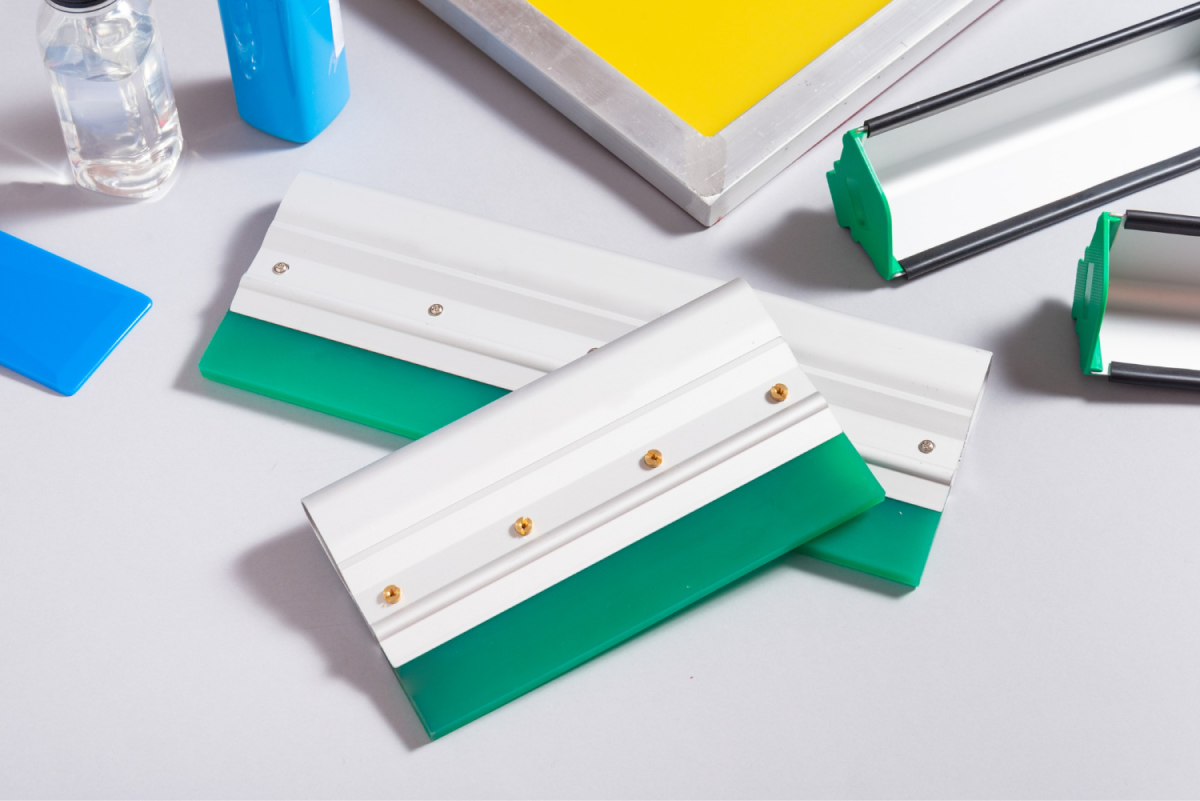.png)
Screen printing lets you transfer ink through a mesh screen onto different materials. This technique creates everything from custom t-shirts to business signs. Understanding how screen printing works is significant for anyone who wants to explore custom printing, whether for business or personal projects.
Screen Printing Basics
Screen printing has transformed the world of custom printing into a versatile modern printing powerhouse. Screen printing works by pushing ink through a mesh screen onto a surface. This creates durable designs that last.
.png)
How does screen printing work?A fine mesh screen stretches across a frame like a window screen. The process uses a stencil, called the "emulsion,” on this screen that blocks some areas while leaving others open. A rubber blade called a squeegee presses ink across the screen, and it passes through the open areas onto the material below to create the desired design. Screen printing can now be used for multiple commercial products!
-
Custom t-shirts and apparel
-
Promotional items and merchandise
-
Signage and banners
-
Business cards and stationery
Screen printing works well on materials of all types. Modern techniques achieve effects that other printing methods cannot match. This process can get you anything from ultra-vibrant colors on dark fabrics to special effects like glitter and metallic finishes.
Screen printing stands out because it produces consistent results for one item or thousands. Businesses choose this method for its reliability and durability to create lasting impressions through custom printed products.
Important Screen Printing Equipment
Each component plays an important role in creating perfect prints that customers love.

Screen printing frames and mesh
Quality frames and mesh form the foundation of any screen printing setup. The frame serves as the canvas that holds everything together. Wooden frames provide a budget-friendly option for beginners while aluminum frames remain the professional's choice because of their durability and resistance to warping.
The mesh count (threads per square inch) determines what you can print!
-
110 mesh - Perfect for simple designs and white ink on dark fabrics
-
156 mesh - The versatile all-rounder for most projects
-
230-305 mesh - Ideal for detailed artwork and halftones
Squeegees and inks
Squeegees and inks work together to bring designs to life. Squeegees come in different durometers (hardness levels), and 70 durometer hits the sweet spot for most applications. Plastisol and water-based ink are the popular options. Plastisol won't dry on the screen and delivers bright colors. Water-based inks give a softer feel but need more attention during printing.
Drying and curing equipment
Proper curing equipment is also vital. The right temperature matters whether you use a heat press, flash dryer, or conveyor dryer. Plastisol inks need 3>300-330°F for proper curing, and water-based inks require 300-320°F. Flash dryers suit beginners and small shops perfectly while conveyor dryers are great for high-volume production.
Are you looking for a dependable screen printing provider? Rapid Printing & Designs in Victoria, Texas is here to help meet the needs of the area!
The Screen Printing Process Step-by-Step
Screen printing takes a simple design and turns it into something special through several steps.
Design preparation and film output
Great prints start with proper artwork preparation. Quality is very important. The original artwork's quality directly affects the final print. Professional printers use specialized software like Adobe Illustrator or Photoshop to separate colors and clean up designs. Each color needs its own screen, so artwork must be separated into individual layers. These designs are printed onto transparent films called "film positives" once they're ready.
Screen preparation and emulsion coating
The darkroom is where the printing happens as screens are prepared with photosensitive emulsion. The process needs specific conditions:
-
Clean and degrease the screen
-
Apply emulsion evenly using a scoop coater
-
Dry in a controlled environment
-
Expose the screen with film positive
-
Wash out unexposed areas
Printing technique and color layering
The printing process begins with prepared screens. Colors print separately and build the design layer by layer. Registration is critical. Colors must arrange perfectly to create the intended design. Professional printers use these quality control measures!
-
Test prints before full production
-
Flash-curing between colors when needed
-
Proper ink curing at specific temperatures
Multiple color work needs attention to detail and patience.
Pro tip: Always start with the lightest color and work your way to darker shades to get the best results.
Materials and Fabrics for Screen Printing
Different fabrics hold different designs that make heads turn in their own special ways.

Best fabrics for screen printing
Cotton stands at the top of the screen printing world. Natural fibers absorb ink and long-lasting prints. Businesses that create promotional items or custom t-shirts find cotton and cotton blends provide the perfect balance of quality and affordable solutions. These fabrics also excel in screen printing!
-
Silk - A smooth surface ideal for high-end designs
-
Cotton-polyester blends - Combines durability with print quality
-
Wool blends - Great for specialty items
Ink types and their applications
Plastisol ink serves as the industry's best by delivering bright colors that sit boldly on fabric surfaces. Logos and designs that make strong statements benefit from this ink. Water-based inks create a different effect by soaking into the fabric and producing a barely-there feel that many people love. The ink blends well with the fabric and produces prints that last through many washing cycles.
Special effects and finishes
Modern printing techniques add an extra wow factor. Metallic finishes can catch light and grab attention which is perfect for brand logos that need to pop. Puff inks produce raised designs that add texture while glitter effects bring sparkle to any design. These special effects turn ordinary promotional items into conversation starters.
Do You Need Screen Printing Services?
Screen printing transforms simple materials into awesome custom products. This technique produces professional results in applications of all types, from business merchandise to promotional items. Rapid Printing & Designs in Victoria, Texas excels at bringing these elements together. Our team creates everything from simple one-color designs to intricate multi-color projects. Reach out to us today if you are in need of screen printing services!
Screen Printing FAQs
What exactly is screen printing and how does it function?
Screen printing is a technique where ink is pushed through a mesh screen onto a substrate. By making certain areas of the screen impermeable to the ink using a stencil, the ink that does pass through forms the desired image on the substrate.
What are the advantages and disadvantages of screen printing?
Screen printing is very sustainable for large-scale productions. However, it does have drawbacks such as higher costs for designs involving multiple colors and less efficiency for small print runs.
Why opt for screen printing?
Screen printing is useful for producing bright and attractive canvases, posters, and artworks. Additionally, it is widely used for printing on fabrics, which makes it ideal for creating a variety of custom clothing and products.
